Project Duration : June 2016 – Ongoing
About : AGV Research Group, is one of the leading research group on Autonomous Cars in India, aimed towards developing a fully autonomous and safe self-driving car.
We are one of the top 10 finalists among 400+ organisations, competing for Mahindra Driver-less Car Rise Prize Challenge, for the dream of achieving complete autonomy in the Indian environment and the grand prize of 1 million USD.
We were entrusted with the task to convert the Mahindra e2o electric vehicle into a fully autonomous vehicle.
Worked On : External Wheel Encoder, Visual Odometry, Sparse Map and vision based Localisation, Offboard Communication.
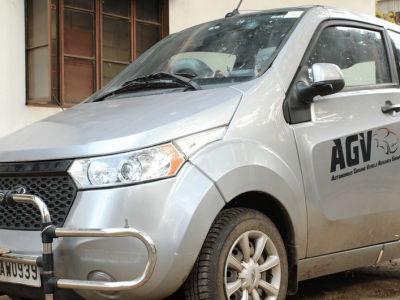
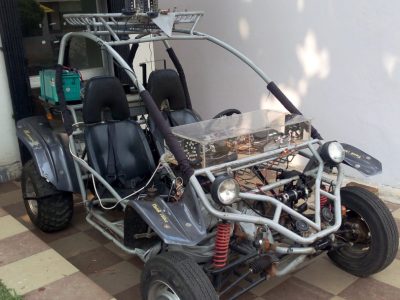
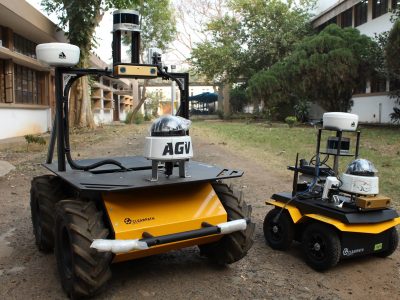
Mahindra E20 : Provided by Mahindra for Automation. CAN -bus protocol based Throttle, Brake and other Controllers are integrated with the system. Sensors includes IMU, GPS and detachable Monocular / Stereo Camera, 3D and 2D LiDAR. Our final goal is to always test our work on real commercial vehicle.
Dune Buggy : All the algorithms are first being tested on a dune buggy platform which we have modified to control via a laptop, using a servomotor based throttle, a heavy duty motor based steering and another one for braking, controlled via a Roboteq controller with ROS integration.
Testing Prototypes : Husky and Jackal by Clearpath Robotics, are our testing prototypes, used for testing algorithms and modules, before testing on Dune Buggy and Mahindra. The are fully equiped with sensors including, GPS, IMU, Stereo Camera, Monocular Camera, Pan-Tilt-Zoom Camera, 3D LiDAR, Long range communication system and Processing unit.
Other than this, we also have our very own developed prototype Eklavya 6.0 and Eklavya 7.0.
Contributions to the Project
May 2019 – Present
Complete pipeline for Pointcloud matching based localisation state correction with efficient odometry based estimation, to localise in gps-denied mapped environment with efficient computation. Global merged map is stored as divided blocks that are dynamically imported to save memory. Read More About it : Localisation In Mapped Environment [ LIME ]
Offboard – Time Delayed Computation
September 2019 – Present
Problem Statement 2 :
Computational and Power capability and constraints are one of the most challenging problem statements in autonomous industries.
Increasing functionality requires more computational power and thus power requirement. As both these factors have hard constraints due to limited space and cost, by switching to offboard server computation we can process more information with no power load on the vehicle.
The obvious problem associated with it is the Real Time data processing requirement in such systems. I am solving the same using Time Delayed Computational Model with Local Approximation.
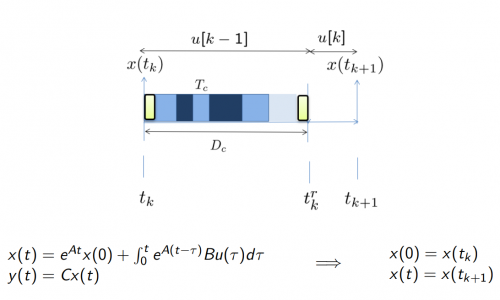
Non-Intrusive Inertial Odometry Sensor
July 2018 – December 2018 | August 2019 – Present
Problem Statement 1 : Poor Resolution of default Encoder Feedback.
The resolution of default encoder had a least count of 1kmph, which was very poor to be used as feedback for Planning and Controls Module.
How I Solved It : I contributed in developing an External – Intelligent Non-Intrusive Inertial based Odometry sensor for Ground Vehicle. These sensors could be placed externally on the rim of tyre, and it determines the car’s odometry.
The sensor used angular velocity reading from the inertial sensor, and transmitted it to the wireless receiver unit inside car through nRF, which filtered the noise and bias using Kalman Filter.
My contributions were acknowledged in the published research paper on the same, at IEEE International Conference for Industrial Automation, Australia, 2019.
Further Work : I solved the data latency issues, and switched to Xbee from nRF for a more reliable and parallel communication. The constraint of the sensor was that it needed to be placed exactly perpendicular to the ground plane, else the angular velocity component due to turning of car, introduces a large error.
I solved this major issue, by coming up with a better mathematical model which completely eliminated this error.
Read More About It : Non-Intrusive Inertial Sensor for Odometry of a Ground Vehicle
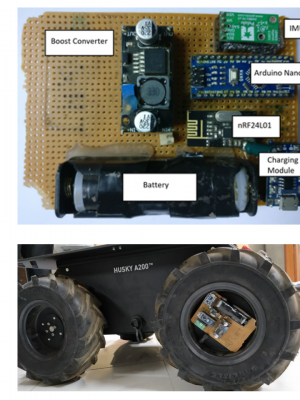
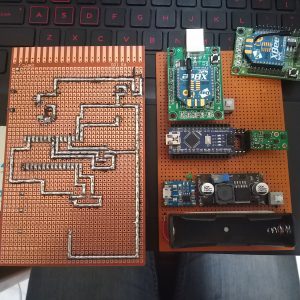
Drive-by Wire Setup
Non-Intrusive Inertial Odometry Sensor
July 2018 – September 2018
Credits : Manthan Patel, Adarsh Patnaik
The first task to be worked upon was to make the e2o controllable using the joystick. The car came preinstalled with the motors for steering control and gas pedal-brake. Moreover, the car could be interfaced using the CAN protocol. CAN stands for Controller Area Network and it allows microcontrollers and devices to communicate with each other in applications without a host computer. With the help of CAN, the various electronic devices can exchange information with each other over a common serial bus. The other benefit of using the CAN protocol is that we can provide priority-based commands to the vehicle and thus it can handle the emergency situations without much trouble. We mapped the joystick buttons for different CAN commands like the velocity increment-decrement, steering angle increment-decrement, headlights, indicator lights, etc with the help of ROS environment. The video below shows the testing of drive-by-wire control.
